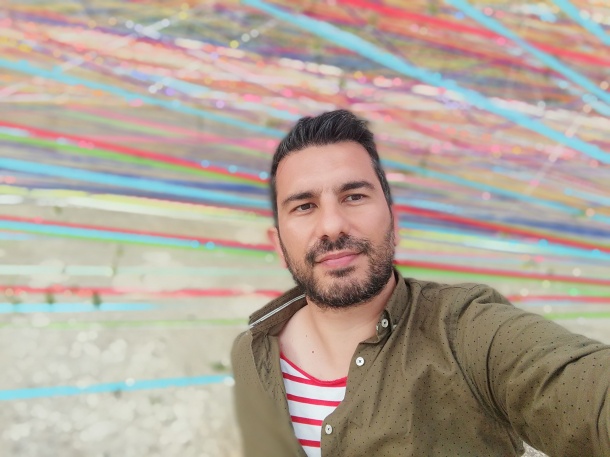
Artist Panagiotis Voulgaris
Stella Sevastopoulos talks to Panagiotis Voulgaris, an artist-traveller, whose special relationship with nature and the urban environment have inspired his ephemeral artistic interventions. He is also the co-director of FokiaNou art space together with artist Mary Cox.
PANAGIOTIS Voulgaris creates monuments to nature that revere the natural environment to such an extent, that they become one with it, and defy the traditional nature of monumental art. His ephemeral interventions on the natural landscape, or the urban landscape, are testimonies of his meditative approach to art, where every footstep counts. They say that ‘the world is your oyster’, but in Voulgaris’s case, it is his studio, because rather than close himself from the outside world to create his art, Voulgaris draws directly on the objects of the outside world, where he traces the course of light, or makes marks along his travels that form larger ‘constellations’. He maps out his artistic territory in a discrete fashion, with humble, light and portable materials in his backpack, such as silk thread, masking tape, and small figurines. He sets off like a traveler, ready to meet and engage with people in the process, because this kind of artistic process – an alternative kind of street art of a conceptual character – is first witnessed by the general public, and not by the closed circuit of the artistic kind. In contrast to these kinds of art projects, Voulgaris’s video art is a different affair – a more dramatic perspective on the ironies of life, and especially of the Greek crisis.
Voulgaris has travelled a lot for his art, realizing projects in countries such as Italy, Malta, France, Turkey, Spain, Brazil, Sweden, the US as well as around Greece. In 2018 he was awarded as a resident artist of Valetta, 2018, The European Capital of Culture, and he recently gained the STEP travel grant from the European Cultural Foundation and the Compania di San Paolo. At the same time however, together with artist Mary Cox, Voulgaris co-directs the FokiaNou art space, which he describes as an “ongoing art project”. Many artist-run spaces have emerged in Athens in recent years, creating an alternative art scene, that were planned to be celebrated via a three-day festival, March 13-15, organized by Athens ArtCore (a recently-formed association of artist-run spaces), with the theme ‘Death in Athens’. However, due to the Corona virus outbreak, the festival had to be canceled:
– Tell us about Athens ArtCore’s festival and your participation
– More than 20 artist run spaces and entities were participating. For this three-day event FokiaNou had organized a group show of eight artists, including Mary Cox and myself in Exarcheia, at Studio 80A. One of the participant artists and co-curators of the show, Sarah Ettlinger has her studio in a beautiful neoclassical building which is a very inspiring old space, so we decided to travel as FokiaNou Art Space from Pangrati and have an exhibition there. Meanwhile at FokiaNou’s space in Pangrati, Maria Bourbou’s ‘Nude’ photography show (which opened on March 7), will continue till March 28.
– FokiaNou art space, is a unique artist-run space. What’s the aim there?
– We give the opportunity to artists who find it difficult to exhibit their work, to be able to do so here. In Greece this is an issue. Even the open calls that we do, are such an opportunity. And open calls weren’t that popular in Greece until recently. They give us the opportunity to see the work of many artists that we wouldn’t have come across, and they bring artists together. With every open call, our art community grows. Artist-run spaces are focused on helping artists. We’re not art dealers.
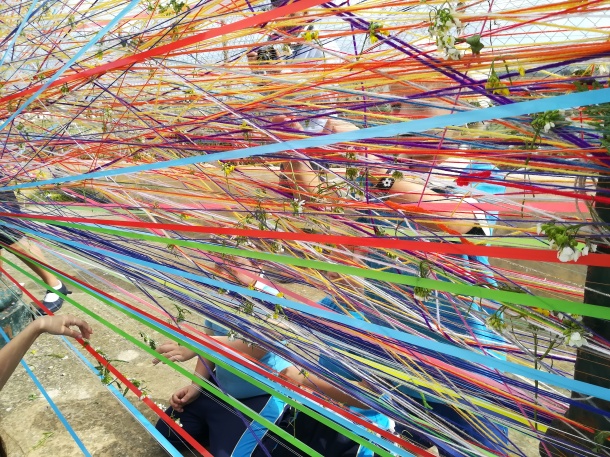
Close-up of children at work on Voulgaris’s project in Malta
– The crisis in Greece deeply affected its artworld. It made artists look for alternative, more economic ways of art promotion. The internet was one. Artist-run spaces (such as FokiaNou), also emerged in Greece during the crisis.
– The internet provides a platform, from which you can show your work to a much larger audience, without the middleman. Of course, it also depends on what kind of work you are producing. It’s easier for photographic work, or paintings for example. For installation art it’s not the same, because you need to experience it. However, all these alternative means of promoting art have emerged over the last few years, including artist-run spaces, and have provided new platforms for artists. It’s because artists had to adapt to the new situation that emerged with the crisis, and find ways of continuing their creative process. So, these artist-run spaces (also some residencies), have now become part of the city, and are adding to it culturally. They are like cultural cores around town, creating their own communities.
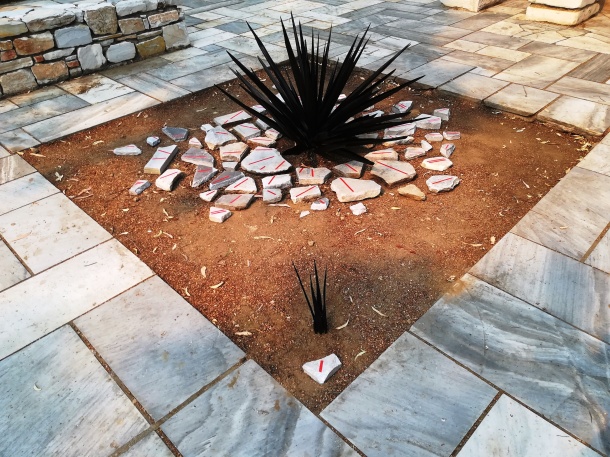
Voulgaris’s installation at the Garden of the Virgin Mary Textile School, Tinos
– FokiaNou was one of the first artist-run spaces in Athens (initially created in 2014 by Blanka Amezkua).
– And is one which has continued to go from strength to strength. We have a full programme of events from September to June. Workshops, talks, exhibitions etc. We organize open call group shows, solo shows, or shows with two artists (one Greek and one foreign). So, I think that the reason why we are so popular both with the press and the public, is because they see that we are serious and steady in what we do. And that we are constantly developing. The whole heterodox and contradictory character of Athens has been expressed through these kinds of spaces, and they are building their own network, helping in the artistic development of Athens. A new kind of creative network needed to develop during the crisis, and this is it. So, that’s one positive thing that came out of the crisis.
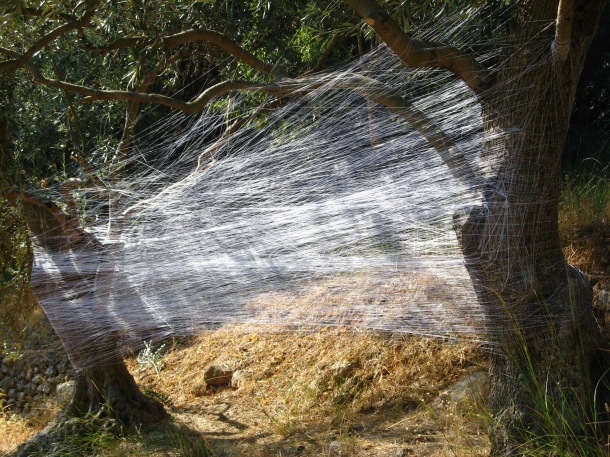
One of Vougaris’s ‘Monument for the Olive Grove’ installations
– Let’s talk about your art, which is very intriguing and different, especially in terms of the materials that you use, e.g. silk threads, masking tape. Why did you choose these materials?
– Thread, because it’s very sensitive, beautiful, white, delicate. And I wanted to take it outdoors, outside of its usual context. Also, I like the way that such a small thing can create something much larger when you start to weave it around forms in the environment. Masking tape has a similar logic to it also. Plus, I like to have materials that are easy to transport. I also want the materials to be cheap and easy to find.
– There is that element of playfulness in your installations in the natural environment.
– I grew up in a small village, Fthiotida, by the sea, surrounded by olive groves. One of these olive groves was a place where all of the children would play. So, I had a special relationship with the earth, and nature. As a young child I was always constructing things in that environment. My creative process is an extension of that process of happiness and magic I had experienced as a child. Nothing else is important for that child at that moment in time. You are in the moment. So, this artistic process is also similar. You start off with your relationship with nature, and the scale of it, how you are something very small in comparison. Whatever you do, whatever the creative process, whatever time it takes, from a few minutes to months or years, at the end of the day, it’s something very small in comparison to the timescale of nature. It’s your little world that’s part of something much bigger. I think that this kind of relationship with nature in terms of scale, always plays a role in my work.
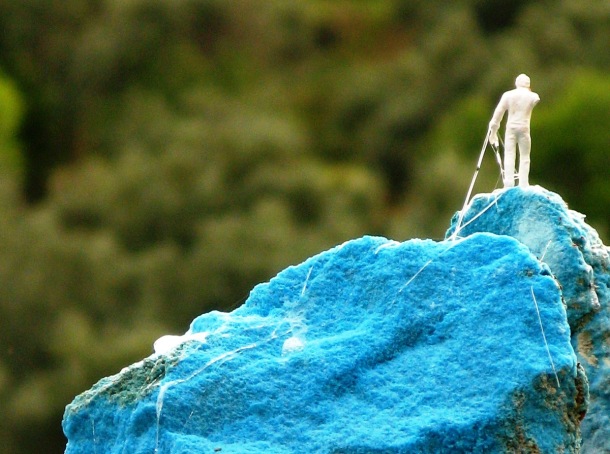
Partial view of ‘The Temptation Of the Mountain I’
– For example the work ‘The Temptation Of The Mountain I’, realized in Amfissa, comprising of a little figurine standing on a blue mountain.
– That mountain is made of large chunks of copper fertilizer. The little person placed on the mountain, is looking at the real mountain in front of him. There is also a reference to Caspar David Friedrich’s work, and German Romanticism. It’s a monument to nature.
– Your concept of the ‘monument’ is kind of anti-monumental. Your ‘Monument for the Olive Grove’ works, are thread installations, like giant spider’s webs woven around olive trees.
– What exactly is a monument? In the traditional sense, it is usually made of marble for example, and is something very permanent, that can stand the test of time. But my monuments are of a different nature. I take a thin thread which in terms of colour (white), connects with the traditional colour of a white marble monument, but in terms of characteristics, is totally different. My monuments are created for nature. They are ephemeral, and they are changed by nature. The process of making them is ritualistic and meditative, involving me counting my steps, or the amount of times the thread travels around the olive trees. By recording your steps in this way, counting 3000 steps for example, you are also recording your relationship with nature. You are making something which is ephemeral, and not trying so much to make an intervention on the landscape, but instead to create a new relationship with it. For example, with the use of a thread which is 10 km long, when it is woven between two trees, it creates something else. A form which captures the light, and changes appearance according to the light and the weather. It can appear solid like marble, or transparent, according to the time of day. The wind blows through it, things get caught in it, like cicada skins and flowers. It continues to become part of the natural environment.
– It’s a gentle intervention on nature, a reverence for nature. Anti-monumental in a sense, because of the ephemeral nature of the materials used.
– Yes, and this for me is the beauty of it. The aim is to become one with what is bigger than you. It’s a process of atonement, or of becoming one with the environment. The sound and motion of the work also play a role. It’s like drawing in the environment. Some of the works also have a course which viewers can follow.

Thread and masking tape are combined in this work, part of the ‘8 to 8’ project
– There’s an ‘arte povera’ side to your creative process.
– It is a movement close to my heart. But also the Greek crisis played a role. These humble materials allowed me to continue my work as an artist. For me, my studio is the outside environment. I always work outside. And these materials allowed me to continue my creative process without any major support, either from a technical aspect, or a monetary one. It’s a beautiful material, and practical, for my kind of art. I like the way that a small spool of thread can be turned into a giant work in nature or the urban environment. I started using thread, and then later turned to masking tape when I realized the ‘8 to 8’ project for Blanka Amezkua in 2012, which involved travelling through Athens, from the cemetery of Kerameikos, following the path of the sun and travelling towards the west, ending up in Plato’s Academy (Akadimia Platonos). I was making marks on the city, as a street artist would, but my material wasn’t a spray can, but masking tape. It’s not a permanent mark. It’s a quiet material. Subtle.
– How do people react to you when they see you creating your art on the street?
– I like the idea of taking art to the world. Some might just ask what you’re doing, and continue on their way, others might become interested. When you’re outside creating art, you’re not protected, but you will meet lots of different people. One old lady said to me “I don’t understand what you’re doing, but it’s one of the most beautiful things I have ever seen”. And my kind of art isn’t easily understandable for the general public, it’s not like a representational painting for example. It’s conceptual. But the reactions to it nevertheless are positive. Sometimes, people who don’t have a relationship with art can understand it if you take the time to explain it to them.
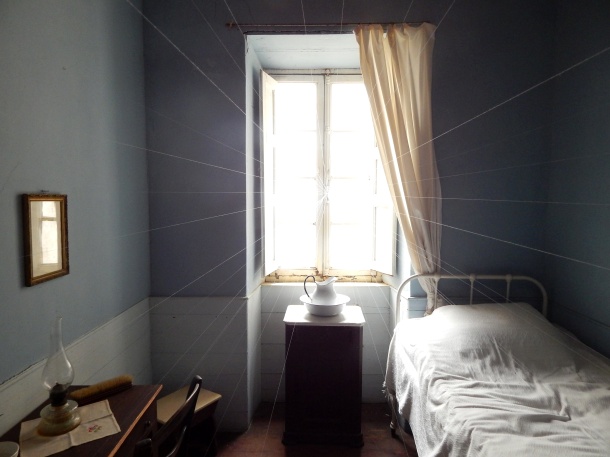
Jasmine-scented threads made up one of Voulgaris’s in situ works at the Ursulines Convent Museum, Tinos
– You also have a special relationship with Tinos, where you have realized two installations (‘The Year of Hibernation II’, 2018, and ‘Engaged Touches’, 2017).
– I have spent two summers in Tinos creating works there. One was in the Ursulines Convent Museum in 2017: A thread installation with jasmine perfumed thread. Perfume is connected with femininity but also with the rituals of religion. The following year I realized a work there in the Garden of the Virgin Mary Textile School, where I created an installation with plants and rocks, which resembled a solar clock. Plants are something I have used in other works too. In this case, some of the plants had been given to me by the women of the textile school, and these were returned to them later. I like this idea of giving back to the community, and also working with the community through the art process.
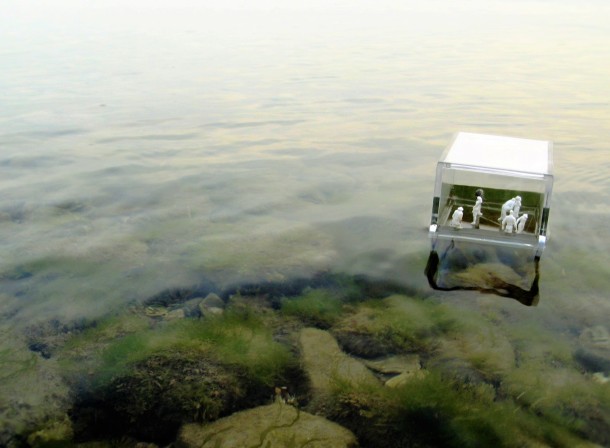
Photo of one of Voulgaris’ ‘Vessels’ sent off to sea
– The ‘Vessels’ series (2008-12), is an interesting perspective on immigration, where you have placed little white figurines in plexiglass boxes and have embarked them on watery journeys.
– There are different scenarios going on between the figurines in their plexiglass containers. I have placed these works in different countries, in rivers or seas: It began in 2008, in Berlin, then Budapest, Athens, and the Mallian Gulf. It’s a comment on water, and how it joins cultures and people. In the last few years, due to the influx of refugees and the whole issue of immigration, this work took on a new meaning. And that was interesting, although travelling cultures and people have always been part of human existence.

Voulgaris worked with 3 schools in Malta, for the project ‘Constellations/Settlements. The 212,524 Steps’, part of Valetta’s European Capitol of Culture events
– Let’s talk about your award-winning project ‘Constellations/Settlements. The 212,524 Steps’, in Malta, part of Valetta’s European Capitol of Culture events.
– Malta was a great experience. I first went there for a symposium, but then returned in October of 2018 to realise this project I had proposed. It was one of the most beautiful experiences I have ever had. The way people live there, reminded me of my own roots. I created various works on the island, and also worked with 3 schools, where the pupils and teachers were involved, and we created works in their playgrounds, with coloured threads and also other objects which we incorporated into the installations. The children added their own objects, from broken toys and pencils, to flowers. These works became part of the schools. All the works on the island that I had created, connected with each other to form a larger ‘constellation’. It’s the idea that lots of little works, create something a lot bigger.
– Your video works are very interesting in comparison, especially the ‘Rightness of Wrongness/Little People Crack Concrete’, created during the Greek crisis (2012-13). Throughout this work there is the sound of a brick crashing, which creates a rhythm, but at the same time sounds like a gun shot. But you end the video, with the sound of a bell, and the image of light on water.
– This was a difficult period in our lives. I love the city of Athens very much, and filming aspects of the city, its buildings, and its contradictory sides, was a way for me to process what was going on at this time. During those years, we would walk along the roads of Athens and they seemed empty. You wanted to leave the city, and felt a negative energy. I wanted to focus on the buildings as if they were the witnesses of what was going on. Many buildings were derelict, or had closed down. At the same time, there were also the classical buildings which I also focused on. I wanted to end the work on a positive note, because that’s how I feel when I’m in this city. For example, when you go up to Lykavittos Hill, and find yourself in a totally different environment, in the olive trees, in nature, with the view of the sea in the distance. All of this helps you breathe and go forward. So, for me, this was a message that whatever happens, it is ephemeral, not permanent. It might be difficult, but it will pass, and something better will come. And light is something that concerns me in all of my works. But besides that, I think the job of the artist, apart from documenting something, even if it is an unpleasant reality, is to be able to offer an answer or antidote.
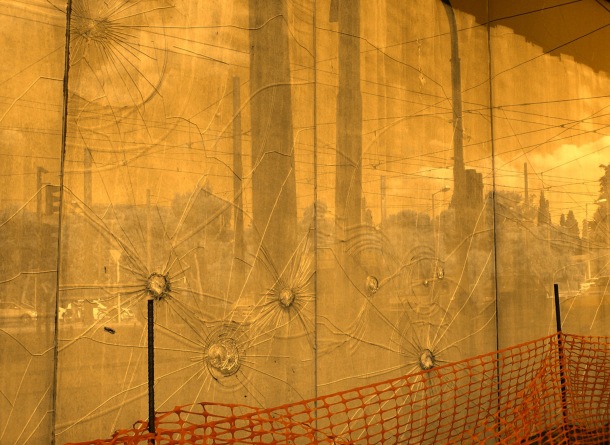
Still from the video work ‘The Rightness of Wrongness/Little People Crack Concrete’
- Check out the following sites to find out more about Voulgaris, FokiaNou, and Athens ArtCore: https://www.behance.net/PanagiotisVoulgaris; https://fokianou247.gr; https://www.athensartcore.com/
Pingback: Lycabettus transformed into art | art scene athens